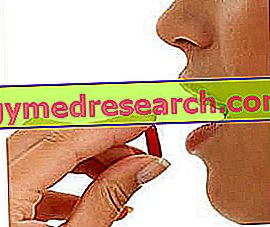Definition and Causes
The term "hepatic steatosis", extracted from the medical language, describes a pathological accumulation of fat and triglycerides in the liver tissue, responsible for serious damage to the liver. There are several forms:
- Alcoholic hepatic steatosis: it depends on an excessive alcohol intake → inflammation of the gastric tissue + depression of the CNS inhibitory centers + cirrhosis;
- Non-alcoholic hepatic steatosis: closely related to obesity, diabetes and the intake of certain drugs (barbiturates, responsible for strengthening the synthesis of fatty acids). It also occurs in subjects who do not take alcohol → steatohepatitis → cirrhosis → liver impairment
- Pregnancy hepatic steatosis (caused mainly by hormonal variation)
Symptoms
Many individuals find that they are suffering from hepatic steatosis: in most cases, in fact, the disease starts asymptomatically. In others, however, hepatic steatosis can cause serious consequences: steatohepatitis (inflammation of the liver), damage to hepatocytes with scarring, cirrhosis; these complications may be accompanied by pain in the upper right abdominal area, fatigue and weight loss.
Natural Care
Information on fatty liver - drugs for the treatment of hepatic steatosis is not intended to replace the direct relationship between health professional and patient. Always consult your doctor and / or specialist before taking Fatty Liver - Steatosis Healing Drugs.
drugs
Unfortunately, there is no pharmacological treatment that can completely resolve non-alcoholic hepatic steatosis; according to this, the drugs and the treatments undertaken aim to treat the causes and the risk factors underlying the problem.
We have seen that obesity is an important causal factor: therefore, it is a good rule to follow a balanced diet, to practice physical exercise and, when necessary, to use products that help low-calorie diets.
When the cause of hepatic steatosis resides in the excessive intake of a drug, it is a good rule to interrupt the treatment, clearly always after consulting a doctor, who will, if necessary, modify the therapy.
The best therapeutic approach for the treatment of the various forms of steatosis consists in the modification of the diet, the lifestyle, as well as taking small simple steps for the prevention of these diseases (for example: limiting the consumption of alcohol). The taking of drugs still remains an unknown factor for the purposes of healing.
Antidiabetic drugs : for the prevention of hepatic steatosis in a diabetic context and to reduce fatty liver symptoms, if the disease was already in place.
- Pioglitazone (eg Actos, Glubrava): antidiabetic drug (class: thiazolidinediones), useful for maintaining glycaemia within the physiological ranges. In monotherapy, take the drug at a dose of 15-30 mg orally once a day. Maintenance dose (for patients who do not respond positively to the initial dosage): increase the dose up to 45 mg per day, oral intake. In combination therapy, it is possible to take pharmacological preparations based on Pioglitazone + Metformin (Competact): take two tablets a day, each formulated with 15 mg of Pioglitazone and 850 mg of Metformin.
- Rosiglitazone (eg, Avandia) this drug is also used in therapy against diabetes, therefore it is useful - albeit indirectly - to prevent diabetes-dependent hepatic steatosis. Take two 4 mg tablets a day. Avandamet is a combined pharmacological preparation (Rosiglitazone + metformin): take 4 tablets per day (each formulated with 1 mg of rosiglitazone and 500 mg of metformin ). In 2010 the commercialization of Avandia and Avandamet was suspended in the European market due to the serious side effects on the cardiovascular level.
Solubilizing drugs to dissolve gall bladder stones: also calculosis is a possible risk factor implicated in hepatic steatosis, therefore solubilizing drugs can prevent liver inflammation.
- Ursodeoxycholic acid or ursodiol (eg Ursobil HT, Ursodes AGE acid, Litursol): it is recommended to take 8-12 mg / kg per os per day in a single dose in the evening or in two divided doses; prolong the therapy up to two years (maintenance therapy: 250 mg a day). It should be pointed out that the pharmacological treatment should be continued even after the complete dissolving of gallbladder stones, given that the disease tends to recur in 25% of patients within 12 months of drug withdrawal.
Antiobesity drugs : also in this case, the drugs belonging to this category are recommended for those obese patients or overweight patients suffering from hepatic steatosis or to prevent liver inflammation.
- ORLISTAT (eg XENICAL, ALLI): take the drug at a dose of 120 mg three times a day, with each main meal containing fat. The drug can be taken during the meal or one hour after the end of the meal.
Nutraceutical products for detoxifying the liver:
- BETAINA (eg Cystadane): natural product extracted from sugar beet ( Beta vulgaris ). Take 6 grams of substance per day, preferably divided into two 3-gram doses. The administration of betaine in patients with hepatic steatosis (alcoholic and non-alcoholic) is recommended for its supposed detoxifying and neuro-protective activities. Hypothetically, betaine supplementation could reduce fat (presumed slimming properties, ideally useful in the prevention of hepatic steatosis); however, the aforementioned therapeutic properties are not yet demonstrated in humans.
Guidelines for the prevention of hepatic steatosis:
Following are some simple dietary-behavioral precautions, essential for improving symptoms of liver stenosis or in its prevention:
- Limit dairy products, sweets and animal fats in general
- Reduce the consumption of vegetable oils and fats (seed and olive oils, etc.)
- Consume good portions of fish several times a week
- Avoid alcohol
- Take vitamin B12 in case of deficiency
- Practicing sports like swimming and running



